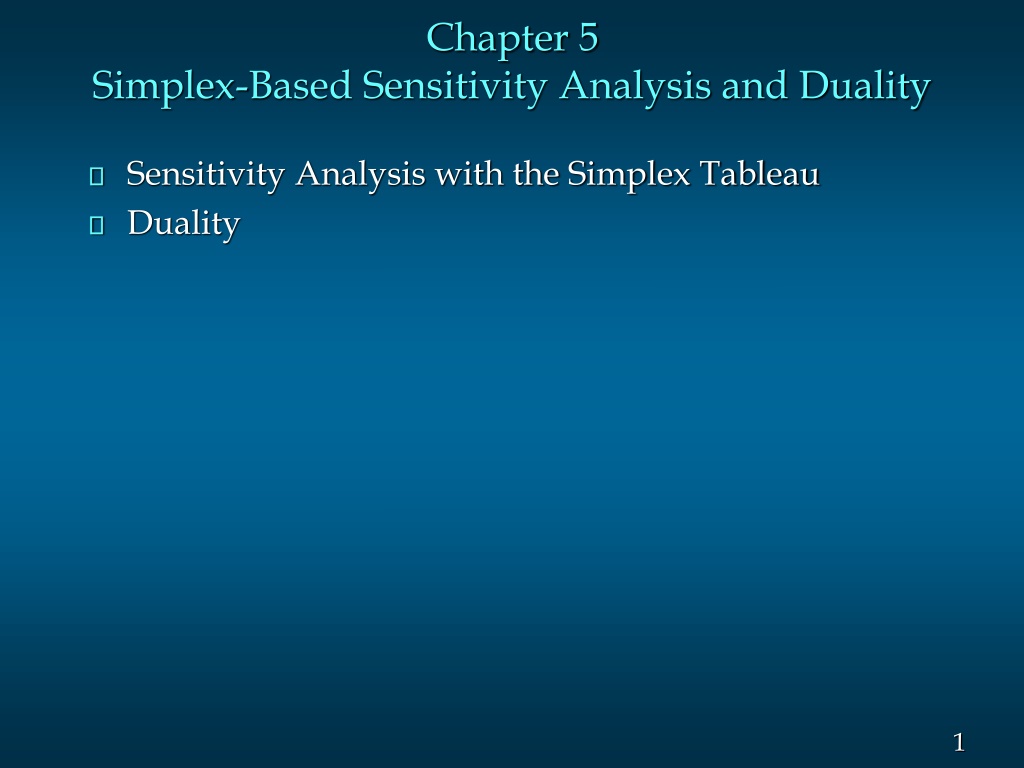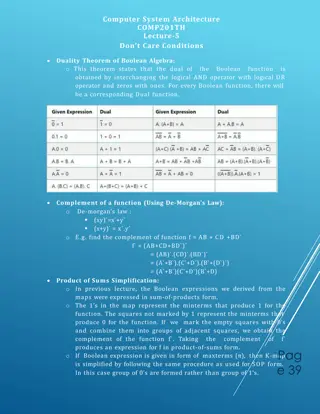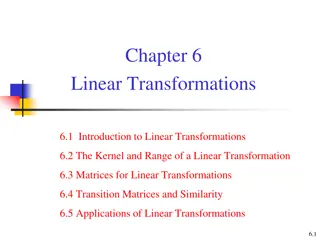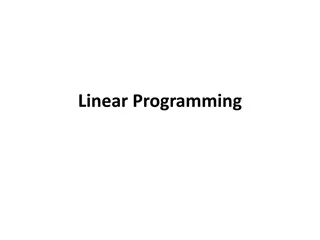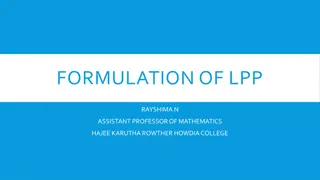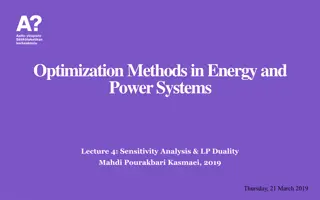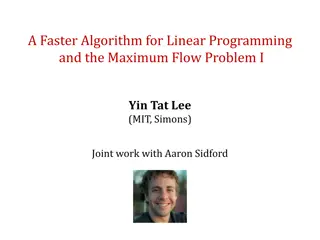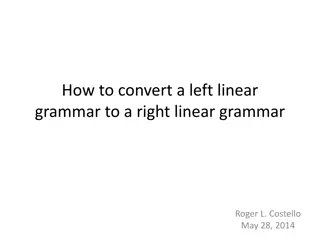Sensitivity Analysis and Duality in Linear Programming
Sensitivity analysis in linear programming involves studying the impact of changes in objective function coefficients and constraint right-hand side values on the optimal solution. It helps in determining the range of optimality for coefficients and shadow prices for constraints. Duality analysis explores the relationships between primal and dual problems, providing valuable insights into optimization problems. This content covers the concepts of range of optimality, shadow prices, and feasibility ranges in the context of linear programming.
Download Presentation

Please find below an Image/Link to download the presentation.
The content on the website is provided AS IS for your information and personal use only. It may not be sold, licensed, or shared on other websites without obtaining consent from the author.If you encounter any issues during the download, it is possible that the publisher has removed the file from their server.
You are allowed to download the files provided on this website for personal or commercial use, subject to the condition that they are used lawfully. All files are the property of their respective owners.
The content on the website is provided AS IS for your information and personal use only. It may not be sold, licensed, or shared on other websites without obtaining consent from the author.
E N D
Presentation Transcript
Chapter 5 Simplex-Based Sensitivity Analysis and Duality Sensitivity Analysis with the Simplex Tableau Duality 1
Objective Function Coefficients and Range of Optimality The range of optimality for an objective function coefficient is the range of that coefficient for which the current optimal solution will remain optimal (keeping all other coefficients constant). The objective function value might change in this range. 2
Objective Function Coefficients and Range of Optimality Given an optimal tableau, the range of optimality for ckcan be calculated as follows: Change the objective function coefficient to ckin the cj row. If xkis basic, then also change the objective function coefficient to ckin the cBcolumn and recalculate the zjrow in terms of ck. Recalculate the cj- zjrow in terms of ck. Determine the range of values for ckthat keep all entries in the cj- zjrow less than or equal to 0. 3
Objective Function Coefficients and Range of Optimality If ckchanges to values outside the range of optimality, a new cj- zjrow may be generated. The simplex method may then be continued to determine a new optimal solution. 4
Shadow Price A shadow price for a constraint is the increase in the objective function value resulting from a one unit increase in its right-hand side value. Shadow prices and dual prices on The Management Scientist output are the same thing for maximization problems and negative of each other for minimization problems. 5
Shadow Price Shadow prices are found in the optimal tableau as follows: "less than or equal to" constraint -- zjvalue of the corresponding slack variable for the constraint "greater than or equal to" constraint -- negative of the zjvalue of the corresponding surplus variable for the constraint "equal to" constraint -- zjvalue of the corresponding artificial variable for the constraint. 6
Right-Hand Side Values and Range of Feasibility The range of feasibility for a right hand side coefficient is the range of that coefficient for which the shadow price remains unchanged. The range of feasibility is also the range for which the current set of basic variables remains the optimal set of basic variables (although their values change.) 7
Right-Hand Side Values and Range of Feasibility The range of feasibility for a right-hand side coefficient of a "less than or equal to" constraint, bk, is calculated as follows: Express the right-hand side in terms of bkby adding bktimes the column of the k-th slack variable to the current optimal right hand side. Determine the range of bkthat keeps the right- hand side greater than or equal to 0. Add the original right-hand side value bk(from the original tableau) to these limits for bkto determine the range of feasibility for bk. 8
Right-Hand Side Values and Range of Feasibility The range of feasibility for "greater than or equal to" constraints is similarly found except one subtracts bk times the current column of the k-th surplus variable from the current right hand side. For equality constraints this range is similarly found by adding bktimes the current column of the k-th artificial variable to the current right hand side. Otherwise the procedure is the same. 9
Simultaneous Changes For simultaneous changes of two or more objective function coefficients the 100% rule provides a guide to whether the optimal solution changes. It states that as long as the sum of the percent changes in the coefficients from their current value to their maximum allowable increase or decrease does not exceed 100%, the solution will not change. Similarly, for shadow prices, the 100% rule can be applied to changes in the the right hand side coefficients. 10
Canonical Form A maximization linear program is said to be in canonical form if all constraints are "less than or equal to" constraints and the variables are non- negative. A minimization linear program is said to be in canonical form if all constraints are "greater than or equal to" constraints and the variables are non- negative. 11
Canonical Form Convert any linear program to a maximization problem in canonical form as follows: minimization objective function: multiply it by -1 "less than or equal to" constraint: leave it alone "greater than or equal to" constraint: multiply it by -1 "equal to" constraint: form two constraints, one "less than or equal to", the other "greater or equal to"; then multiply this "greater than or equal to" constraint by -1. 12
Primal and Dual Problems Every linear program (called the primal) has associated with it another linear program called the dual. The dual of a maximization problem in canonical form is a minimization problem in canonical form. The rows and columns of the two programs are interchanged and hence the objective function coefficients of one are the right hand side values of the other and vice versa. 13
Primal and Dual Problems The optimal value of the objective function of the primal problem equals the optimal value of the objective function of the dual problem. Solving the dual might be computationally more efficient when the primal has numerous constraints and few variables. 14
Primal and Dual Variables The dual variables are the "value per unit" of the corresponding primal resource, i.e. the shadow prices. Thus, they are found in the zjrow of the optimal simplex tableau. If the dual is solved, the optimal primal solution is found in zjrow of the corresponding surplus variable in the optimal dual tableau. The optimal value of the primal's slack variables are the negative of the cj- zjentries in the optimal dual tableau for the dual variables. 15
Example: Jonnis Toy Co. Jonni's Toy Co. produces stuffed toy animals and is gearing up for the Christmas rush by hiring temporary workers giving it a total production crew of 30 workers. Jonni's makes two sizes of stuffed animals. The profit, the production time and the material used per toy animal is summarized on the next slide. Workers work 8 hours per day and there are up to 2000 pounds of material available daily. What is the optimal daily production mix? 16
Example: Jonnis Toy Co. Toy Unit Production Material Used Size Profit Time (hrs.) Small $3 .10 1 Large $8 .30 2 Per Unit (lbs.) 17
Example: Jonnis Toy Co. LP Formulation x1= number of small stuffed animals produced daily x2= number of large stuffed animals produced daily Max 3x1+ 8x2 s.t. .1x1+ .3x2< x1+ 2x2< 2000 240 x1, x2> 0 18
Example: Jonnis Toy Co. Simplex Method: First Tableau x1 x2 s1 s2 Basis cB 3 8 0 0 s1 s2 0 .1 .3 1 0 240 0 1 2 0 1 2000 zj 0 0 0 0 0 3 8 0 0 cj- zj 19
Example: Jonnis Toy Co. Simplex Method: Second Tableau x1 x2 s1 s2 Basis cB 3 8 0 0 x2 s2 8 1/3 1 10/3 0 800 0 1/3 0 -20/3 1 400 zj 8/3 8 80/3 0 6400 1/3 0 -80/3 0 cj- zj 20
Example: Jonnis Toy Co. Simplex Method: Third Tableau x1 x2 s1 s2 Basis cB 3 8 0 0 x2 x1 8 0 1 10 -1 400 3 1 0 -20 3 1200 zj 3 8 20 1 6800 0 0 -20 -1 cj- zj 21
Example: Jonnis Toy Co. Optimal Solution Question: How many animals of each size should be produced daily and what is the resulting daily profit? Answer: Produce 1200 small animals and 400 large animals daily for a total profit of $6,800. 22
Example: Jonnis Toy Co. Range of Optimality for c1(small animals) Replace 3 by c1in the objective function row and cBcolumn. Then recalculate zjand cj- zj rows. zj c1 8 80 -20c1 -8 +3c1 3200 + 1200c1 cj- zj 0 0 -80 +20c1 8 -3c1 For the cj- zjrow to remain non-positive, 8/3 < c1< 4 23
Example: Jonnis Toy Co. Range of Optimality for c2(large animals) Replace 8 by c2in the objective function row and cB column. Then recalculate zjand cj- zj rows. zj 3 c2 -60 +10c2 9 -c2 3600 + 400c2 cj- zj 0 0 60 -10c2 -9 +c2 For the cj- zjrow to remain non-positive, 6 < c2< 9 24
Example: Jonnis Toy Co. Range of Optimality Question: Will the solution change if the profit on small animals is increased by $.75? Will the objective function value change? Answer: If the profit on small stuffed animals is changed to $3.75, this is within the range of optimality and the optimal solution will not change. However, since x1is a basic variable at positive value, changing its objective function coefficient will change the value of the objective function to 3200 + 1200(3.75) = 7700. 25
Example: Jonnis Toy Co. Range of Optimality Question: Will the solution change if the profit on large animals is increased by $.75? Will the objective function value change? Answer: If the profit on large stuffed animals is changed to $8.75, this is within the range of optimality and the optimal solution will not change. However, since x2is a basic variable at positive value, changing its objective function coefficient will change the value of the objective function to 3600 + 400(8.75) = 7100. 26
Example: Jonnis Toy Co. Range of Optimality and 100% Rule Question: Will the solution change if the profits on both large and small animals are increased by $.75? Will the value of the objective function change? Answer: If both the profits change by $.75, since the maximum increase for c1is $1 (from $3 to $4) and the maximum increase in c2is $1 (from $8 to $9), the overall sum of the percent changes is (.75/1) + (.75/1) = 75% + 75% = 150%. This total is greater than 100%; both the optimal solution and the value of the objective function change. 27
Example: Jonnis Toy Co. Shadow Price Question: The unit profits do not include a per unit labor cost. Given this, what is the maximum wage Jonni should pay for overtime? Answer: Since the unit profits do not include a per unit labor cost, man-hours is a sunk cost. Thus the shadow price for man-hours gives the maximum worth of man-hours (overtime). This is found in the zjrow in the s1column (since s1is the slack for man-hours) and is $20. 28
Example: Prime the Cannons! LP Formulation Max 2x1+ x2+ 3x3 s.t. x1+ 2x2+ 3x3< 15 3x1+ 4x2+ 6x3> 24 x1+ x2+ x3= 10 x1, x2, x3> 0 29
Example: Prime the Cannons! Primal in Canonical Form Constraint (1) is a "<" constraint. Leave it alone. Constraint (2) is a ">" constraint. Multiply it by -1. Constraint (3) is an "=" constraint. Rewrite this as two constraints, one a "<", the other a ">" constraint. Then multiply the ">" constraint by -1. (result on next slide) 30
Example: Prime the Cannons! Primal in Canonical Form (continued) Max 2x1+ x2+ 3x3 s.t. x1+ 2x2+ 3x3< 15 -3x1- 4x2- 6x3< -24 x1+ x2+ x3< 10 -x1- x2- x1, x2, x3> 0 x3< -10 31
Example: Prime the Cannons! Dual of the Canonical Primal There are four dual variables, U1, U2, U3', U3". The objective function coefficients of the dual are the RHS of the primal. The RHS of the dual is the objective function coefficients of the primal. The rows of the dual are the columns of the primal. (result on next slide) 32
Example: Prime the Cannons! Dual of the Canonical Primal (continued) Min 15U1- 24U2+ 10U3' - 10U3" s.t. U1- 3U2+ U3' - 2U1- 4U2+ U3' - 3U1- 6U2+ U3' - U3" > 2 U3" > 1 U3" > 3 U1, U2, U3', U3" > 0 33
